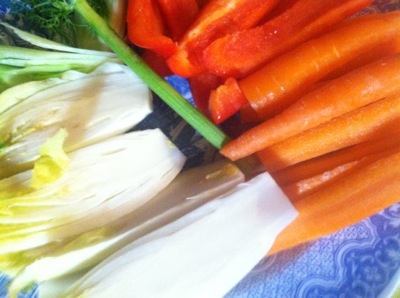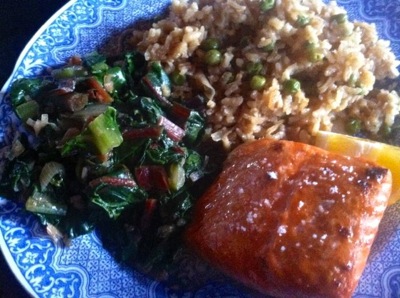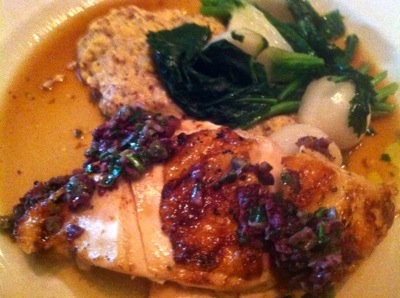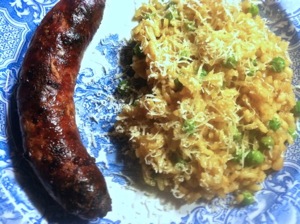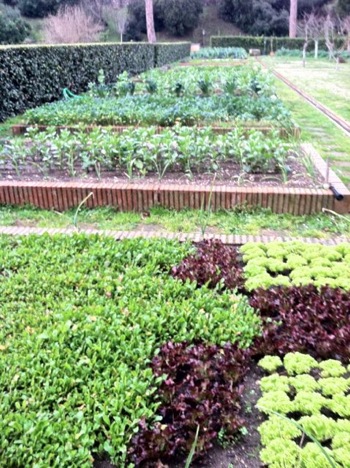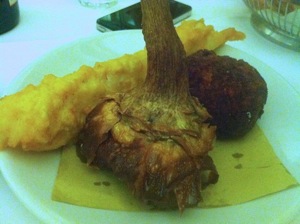Hotel San Francesco, Roma; February 2, 2013—
 A FEW YEARS AGO
A FEW YEARS AGO we found a place in Testaccio we really liked — how we found it, I no longer recall. My fondness for it may have been colored by its name: Nè Arte Nè Parte, an Italian construction, literally "neither art nor party," referring to a person who has neither the necessary technique nor the in-that-case-necessary connections to maintain a profession.
It hasn't turned up in any of the guidebooks or online listings, and I assumed it had gone out of business. But we walked across the bridge to Testaccio today, down the Via Marmorata toward Perilli's, and then turned down the via Alessandro Volta for a block — for here in Testaccio the streets are all regularly spaced at right angles, defining blocks — and there, at the Via Luca Della Robbia, I saw an enoteca, where I asked if the restaurant still existed.
Nè Arte Nè Parte,
si, Signore, esista ancora, the clerk smiled, and waved out the door, It's right across the intersection. But the name is changed, he added; it's now called Gregory.
I looked into the restaurant, where a friendly-looking waiter stood on the sidewalk outside the door. No, he said, the restaurant hasn't really changed; the owner decided Nè Arte Nè Parte was an inconvenient name, his name is Gregory, he changed the name but not the style of the place…
In fact it did, does, look a little changed, not quite as open as it was then, a little more spiffy and less, well, traditional Testaccio. (Testaccio is, or was, the traditionally working-class quarter, given to warehouses, slaughterhouses, and markets. For those of you in the Bay Area: if the
Centro Storico is San Francisco, then Trastevere is in many ways Berkeley, and Testaccio is bayfront Oakland.)
Still, let's try it: we made a date for half an hour later, took a walk around Monte Testaccio and through the new market hall, and returned for midday dinner. Here I began with a
filetto, a battered and deep-fried codfish filet; and then split this fine artichoke
alla giudea with Lindsey, and went on to a very nice spaghetti
caccio e pepe, with finer pecorino than we often have, and beautifully cooked pasta. This was a fine meal.
House white
•Gregory a Testaccio, Via Luca della Robbia 15, Rome

Then, after a long afternoon spent in the Maxxi museum far to the north, and a leisurely walk back through the Storico Centro, we remembered that we really wanted to see how Dar Filettaro was holding up, if it was open. It was open, and jammed, as it often is; a waiter snapped at me to give him some room as he juggled half a dozen one-liter carafe from the taps, through the crowded tables, toward the back.
But even though there were four of us we were immediately made welcome and waved to the very back room, the
sancta sactorum, whose plain wooden tables had been jammed together in one corner to accommodate an extended family of twelve or fourteen people of a number of generations. Here we asked for
filetti and red wine, nothing more, and were immediately satisfied. Things seemed a little less splendid than in years past, but I think that was simply because of the crush and the speed. The woman at my elbow, at the next table, belted down her red wine; the grandfather around the corner from her repeated
che bella compagnia, che bella compagnia; she continually responded
e buono mangiare: and indeed she is right: eating is good. Especially in a comfortable room from 1938, with old photos and prints on the wall, and enthusiastic Italians sharing the largesse.
Red house wine
•Dar Filettaro, Largo dei Librari 88, Rome; 06 6864018

From there we crossed the Ponte Sisto, walked up the Via del Moro, and found ourselves on San Calisto at another place I remembered fondly at just the time we were hungry again, and it was by now suppertime, say 8:30. We've had our
primi, Chuck observed, might as well go in for
secondi.
Ristorante Paris, named for the chef whose last name is in fact Paris, is a serious restaurant with serious ambitions. The menu is grounded in the Roman Jewish style but the execution is subtle and cosmopolitan. Still, I stayed with traditional Roman material, deciding on
abbacchio, lamb in the unique manner you find here — chops cut rather thin from the spine, the bones often splintered somehow in the process, simply grilled in a pan with garlic and a hint of lemon, and served on a bed of arugula. A little hard to get off the bone, like yesterday's oxtail: but very delicious, and very site-specific.
Morellino di Scansano (Tuscany), 2011: mellow and smooth
•Ristorante Paris, Piazza San Calisto, 7a, Rome; 06 5815378
And from there it was back to Fatamorgana for dessert, because it truly is the best gelato we've found so far, and it's only a block or two away. I had two chocolates this time, both dark, mellow, and incredibly smooth, one flavored with orange, the other with rosemary.
•Fatamorgana, Via Roma Libera 11, Rome
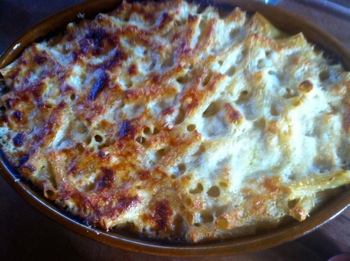
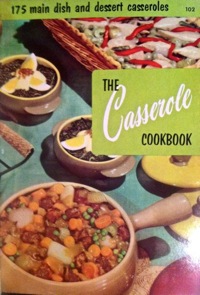

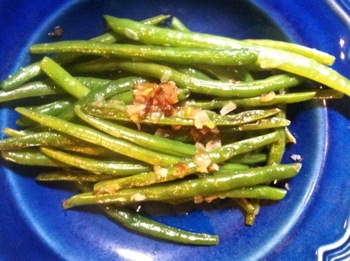

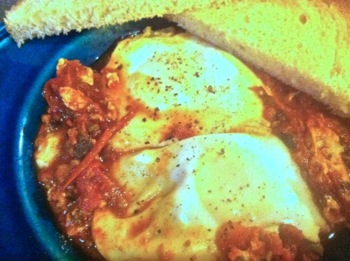
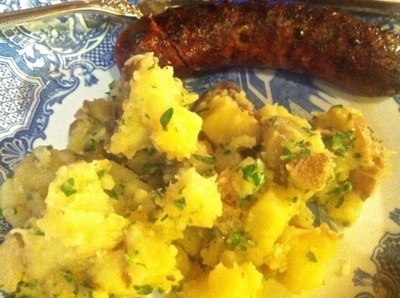
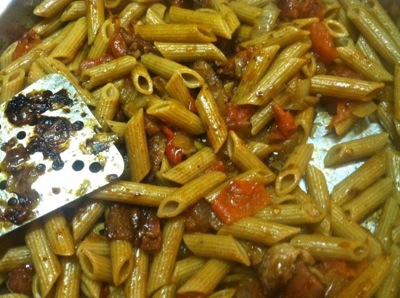

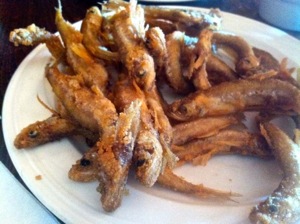 ON, THEN, to a day of sight-seeing: the Mission; the Valley; then a drive up Highway One, stopping for late lunch/early dinner at an old-time roadhouse we'd heard about. Here the lunch menu was very much restricted and dedicated to the nearby sea, with crustacea forbidden to me on most of the offerings. Lindsey happily munched most of these smelt, which seemed over-battered and undersalted to me. (But then, she eats them head, tail, and all, and perhaps gets more flavor therefor: I admit I'm too squeamish.)
ON, THEN, to a day of sight-seeing: the Mission; the Valley; then a drive up Highway One, stopping for late lunch/early dinner at an old-time roadhouse we'd heard about. Here the lunch menu was very much restricted and dedicated to the nearby sea, with crustacea forbidden to me on most of the offerings. Lindsey happily munched most of these smelt, which seemed over-battered and undersalted to me. (But then, she eats them head, tail, and all, and perhaps gets more flavor therefor: I admit I'm too squeamish.) I wish this photo were better, for good as the rest of the dinner was, for once the last course was the capper. But let me go back to first things: This was a meal. We felt we had dined. Each course was interesting and competent, followed its precedent well, and introduced its consequent politely; and at the end we felt nourished and sated and pleased.
I wish this photo were better, for good as the rest of the dinner was, for once the last course was the capper. But let me go back to first things: This was a meal. We felt we had dined. Each course was interesting and competent, followed its precedent well, and introduced its consequent politely; and at the end we felt nourished and sated and pleased.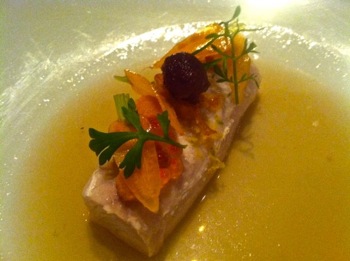
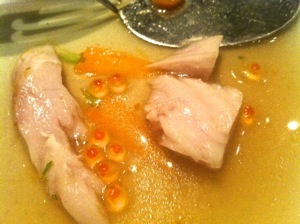 I then did my own deconstruction, of course, as you see at the left. The tuna was perfectly cooked, soft, not quite flaky, creamy; the little trout eggs in their vanilla-coriander bath complemented the color and texture; the paper-thin slices — lengthwise, as I always prefer them, not crosswise — of tiny carrots not a quarter inch long rested atop the fish; the date — which I ate last — rounded everything off, and recalled the similarly spherical and condensed passionfruit in the course that had just preceded.
I then did my own deconstruction, of course, as you see at the left. The tuna was perfectly cooked, soft, not quite flaky, creamy; the little trout eggs in their vanilla-coriander bath complemented the color and texture; the paper-thin slices — lengthwise, as I always prefer them, not crosswise — of tiny carrots not a quarter inch long rested atop the fish; the date — which I ate last — rounded everything off, and recalled the similarly spherical and condensed passionfruit in the course that had just preceded.